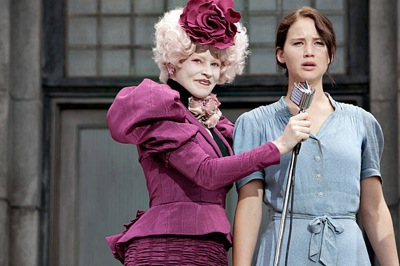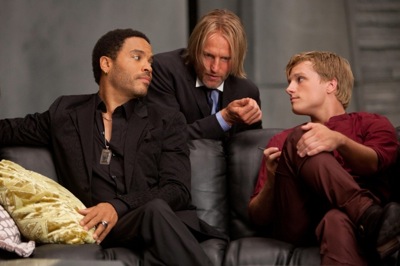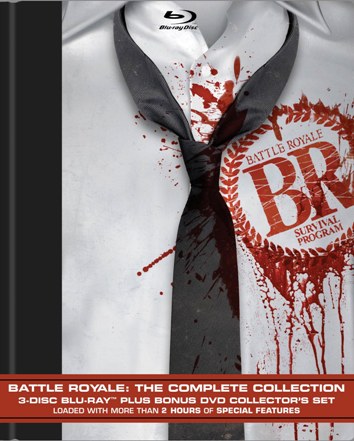 I came late to The Hunger Games. There was a time when books preceded adaptations in my life (Memoirs of a Geisha may be the last book I read in advance of its movie version) but I didn’t know a thing about this one until I read the breathless casting notices online (“Jennifer Lawrence is Katniss!”–what the hell was that about?). It sounded like one of those weird religulous things, like Left Behind. And I wasn’t entirely wrong–those scenes of fruity decadence in “The Capitol,” the silliest sequences in the movie, could be outtakes from Rick Santorum’s “Obamaville” spot. (The way I see it is, we’ve survived four years of Obamaville, toughed it out through eight years of Bushville, and have two or three movies to go with The Capitol. We’ll live.)
I came late to The Hunger Games. There was a time when books preceded adaptations in my life (Memoirs of a Geisha may be the last book I read in advance of its movie version) but I didn’t know a thing about this one until I read the breathless casting notices online (“Jennifer Lawrence is Katniss!”–what the hell was that about?). It sounded like one of those weird religulous things, like Left Behind. And I wasn’t entirely wrong–those scenes of fruity decadence in “The Capitol,” the silliest sequences in the movie, could be outtakes from Rick Santorum’s “Obamaville” spot. (The way I see it is, we’ve survived four years of Obamaville, toughed it out through eight years of Bushville, and have two or three movies to go with The Capitol. We’ll live.)
The Hunger Games, if you’ve just followed me out from the cultural rock that I’d been living under, takes place in Panem, a war-ravaged North America where The Capitol lords it over 12 impoverished districts, and after 74 years of misery people are reduced to naming their kids Katniss and Peeta. (Which maybe isn’t so far-fetched; do you think anyone in 1938 thought “Jaden” would be a hot name in 2012?) The Capitol enforces its rule via The Hunger Games, in which…well, you know. I hate plot summary, particularly when I have to wade through mythological terms like “The Reaping” and all that fantasy stuff. I mean, 318 pages of it on Wiki. Hats off to Suzanne Collins, but reading it as it unfolds is one thing; regurgitating it another.
By and by I like dystopic fantasy stories, not that there are many other options to choose from (cue the “In a world where…” voiceover). I might like Collins’ books; that there are only three is a plus (which, of course, means that the finale will be split into two movies, taking a page from the money-grubbing Harry Potter and Twilight playbooks). But I didn’t much care for The Hunger Games, the movie. This isn’t a total slam: adding a bow and arrow to her woodsy, Oscar-nominated Winter’s Bone portrayal, Lawrence commands the screen as best she can (a Spartacus moment with one of her arrows temporarily rouses the movie), and I liked the folksier passages of James Newton Howard’s score. The movie is better when it stays low to the ground in the backwaters of District 12, which is convincingly played by the state of North Carolina.
 That’s the good news. Little else worked for me. Here we have another adaptation that doesn’t seem to have adapted anything; the movie just spits out plot and exposition and incident for 142 minutes, with nothing under the surface to draw us in outside of a few searching closeups of Lawrence’s face as she plans her next move. And there should be a lot going on under the surface of a movie about kids killing kids in a reality show context. Gary Ross, the co-writer of Big (1988), is the perfectly nice fellow behind Pleasantville (1998), which I adore, and the agreeable film of Seabiscuit (2003). But, like the perfectly nice fellows Shawn Levy (Real Steel) and Chris Columbus (Bicentennial Man), he has no feel whatsoever for this kind of horror- and sci-fi-tinged allegory, and was clearly brought in to make The Hunger Games a safe PG-13 experience, more pleasantville than “Obamaville.” There is one gut-wrenching sequence early on, when the young combatants, loosed on the playing field, slaughter one another, but other than Katniss and the gentle Peeta (Josh Hutcherson) they’ve been given little or no personality, so we don’t grow attached to them. Isabelle Fuhrman, so memorable in the gimmicky Orphan (2009), is in the movie, not that I noticed until her name came up in the closing credits, under the sonic security blanket of Taylor Swift’s theme song, “Safe & Sound.”
That’s the good news. Little else worked for me. Here we have another adaptation that doesn’t seem to have adapted anything; the movie just spits out plot and exposition and incident for 142 minutes, with nothing under the surface to draw us in outside of a few searching closeups of Lawrence’s face as she plans her next move. And there should be a lot going on under the surface of a movie about kids killing kids in a reality show context. Gary Ross, the co-writer of Big (1988), is the perfectly nice fellow behind Pleasantville (1998), which I adore, and the agreeable film of Seabiscuit (2003). But, like the perfectly nice fellows Shawn Levy (Real Steel) and Chris Columbus (Bicentennial Man), he has no feel whatsoever for this kind of horror- and sci-fi-tinged allegory, and was clearly brought in to make The Hunger Games a safe PG-13 experience, more pleasantville than “Obamaville.” There is one gut-wrenching sequence early on, when the young combatants, loosed on the playing field, slaughter one another, but other than Katniss and the gentle Peeta (Josh Hutcherson) they’ve been given little or no personality, so we don’t grow attached to them. Isabelle Fuhrman, so memorable in the gimmicky Orphan (2009), is in the movie, not that I noticed until her name came up in the closing credits, under the sonic security blanket of Taylor Swift’s theme song, “Safe & Sound.”
A movie with this premise–my, how Scholastic Books, which publishes the novels, has changed since I was a kid!–shouldn’t be safe and sound. Katniss spends some of her ordeal in a shakycam coma (Clint Eastwood’s usual DP, Tom Stern, wallows in this and other action movie clichÁ©s), gets a lucky break or two, and mostly has to dispatch the worst of her rivals. There’s one potentially complicated scene, where she and her foes have to make off with bags of necessary supplies for their teams. The smart move would be for Katniss, a frontierswoman with more conscience than her peers, to grab up all the bags, and oblige the others (and their manipulators) to negotiate, which would add a little drama to the flaccidly paced and edited proceedings and allow us more insight into the supporting kids. But, no, the sequence proceeds exactly as you might think. (Nice knowing you, Isabelle.)
 With so much dead time (literal and figurative) on my hands my mind wandered onto other matters, like the chintziness of every Lionsgate production, and how poor, how TV miniseries-level, the adult supporting cast is (yes, that is Lenny Kravitz, who is inoffensive). Stanley Tucci, Donald Sutherland, and Toby Jones are becalmed in archness, Elizabeth Banks is obscured by her Alice in Wonderland makeup and costuming, and Woody Harrelson, who’s been elevated (not unfairly) to some sort of acting god thanks to solid work in Game Change, Rampart, and Friends with Benefits, among others, is dragged down to human level. Then again Ross hasn’t found a tone for them to play in. Collins may be at fault for some of the rest of my gripes, like, why do the Games embrace a volunteer participant like Katniss (surely an independent thinker would pose a threat to the established order)? What role do the Sponsors behind each combatant play? (Other than supplying medicine on little whirlybirds, they don’t seem to do very much to keep their favorites alive.) If the powers-that-be behind the Games can control the environment and create CGI wasps and mutant dogs on the spot, why don’t they abandon all pretense and just rule the districts by terror alone? I would.
With so much dead time (literal and figurative) on my hands my mind wandered onto other matters, like the chintziness of every Lionsgate production, and how poor, how TV miniseries-level, the adult supporting cast is (yes, that is Lenny Kravitz, who is inoffensive). Stanley Tucci, Donald Sutherland, and Toby Jones are becalmed in archness, Elizabeth Banks is obscured by her Alice in Wonderland makeup and costuming, and Woody Harrelson, who’s been elevated (not unfairly) to some sort of acting god thanks to solid work in Game Change, Rampart, and Friends with Benefits, among others, is dragged down to human level. Then again Ross hasn’t found a tone for them to play in. Collins may be at fault for some of the rest of my gripes, like, why do the Games embrace a volunteer participant like Katniss (surely an independent thinker would pose a threat to the established order)? What role do the Sponsors behind each combatant play? (Other than supplying medicine on little whirlybirds, they don’t seem to do very much to keep their favorites alive.) If the powers-that-be behind the Games can control the environment and create CGI wasps and mutant dogs on the spot, why don’t they abandon all pretense and just rule the districts by terror alone? I would.
Maybe the answers to these and other questions can be found in the books. A purpose of adaptation is to fix, or discard, the weak material, but the filmmakers behind The Hunger Games, Twilight, and Harry Potter are paralyzed by their audiences’ embrace of the text. Everything seems to make it in. That’s a lovely thing in our digital, post-print world, but, by the gods, nothing happened in the first Deathly Hallows film, and the Twilights are bloodless from beginning to end. Yet, strangely, audiences come. Surely they realize how unsatisfying these rote, unimaginative movies are. Are they reading along on their Kindles? Texting? Beats me, and I fear we’re as enslaved as Katniss and her friends by their passive acceptance. Reading is fundamental–and also the enemy of engaged, creative filmmaking that should embrace the spirit of a book and never altogether its letter.
 Still, The Hunger Games got me through the door, which is more than can be said for the latter installments of Team Edward and Team Harry, which I fast-forward through on cable or home video. Declawed and unrewarding though it is–Team Katniss can’t rely on my Sponsorship–it does crossbreed dystopias with another subgenre I like, humans-hunting-humans. Collins said her inspiration was TV viewing that juxtaposed Iraq War reports with reality shows…and if she threw in elements of, say, The Most Dangerous Game (1932), or The Naked Prey (1966), or Hard Target (1993), well, she shares my good taste in humans-hunting-humans flicks.
Still, The Hunger Games got me through the door, which is more than can be said for the latter installments of Team Edward and Team Harry, which I fast-forward through on cable or home video. Declawed and unrewarding though it is–Team Katniss can’t rely on my Sponsorship–it does crossbreed dystopias with another subgenre I like, humans-hunting-humans. Collins said her inspiration was TV viewing that juxtaposed Iraq War reports with reality shows…and if she threw in elements of, say, The Most Dangerous Game (1932), or The Naked Prey (1966), or Hard Target (1993), well, she shares my good taste in humans-hunting-humans flicks.
The publicity for Battle Royale: The Complete Collection, now on Blu-ray and DVD, stresses the parallels (or should we say liftings?) between two notorious Japanese films and The Hunger Games. Sure, there are similarities. Minus one: there’s less allegory and more acidity to Battle Royale (2000), which is set smack in a miserabilist Japan, a Japan that can’t say anything and has resorted to the competitive killing of ninth graders to maintain order among its restive youth. I can’t imagine The Christian Science Monitor, which endorsed The Hunger Games (85% fresh on Rotten Tomatoes, so what do I know?) as a “moral parable” suitable for “multigenerational bonding,” advocating Battle Royale and its 2003 sequel as family viewing.
Fact is, I couldn’t hack it, not on first viewing, anyway. Normal people like Collins don’t spend the bucks to obtain bootleg tapes and discs of Japanese movies that go unreleased here, but even my bent self found Battle Royale subversive in a skin-crawling way. With Columbine still fresh its first horrific sequence of bloodshed among the imprisoned kids and their tutors (chief among them the cult star Takeshi Kitano) didn’t sit real well, and it took some time before I could revisit it. (Quentin Tarantino was an early adopter, and cast the fetching Chiaki Kuriyama as the schoolgirl assassin “Gogo” in 2003’s Kill Bill.) It’s worth the effort–you don’t pause to think how the children of a pacifist nation could so quickly adapt to weapons–and the superior, legitimate presentation on Blu-ray is, short of an actual theatrical release, the showcase it required. (You get two cuts of the movie, the sequel, and a fourth DVD of extras.) The supplements within this package thorough and extensive, notably the focus on its director, Kinji Fukasaku. Best known here for directing the beloved monster movie The Green Slime (1968) and the Japanese side of Tora! Tora! Tora! (1970), Fukasaku was noted at home for corrosive gangster films like 1973’s Battle Without Honor and Humanity, and the outrage of those movies bleeds right into Battle Royale. (Lacking the strong, clean line of his vision, the sequel, directed almost entirely by his son following his death, is a muddle.)
What differentiates The Hunger Games from Battle Royale is direct experience. Collins (who I bet has seen 1987’s The Running Man) took her book from TV; Fukasaku’s adaptation of the Battle Royale novel is informed by his own uneasy youth as a World War II munitions worker. Katniss stands her ground throughout her ordeal, while Battle Royale feels like something that will go off the cliff at any moment.
[youtube id=”Y-T7yPJVvXw” width=”600″ height=”350″]




Comments